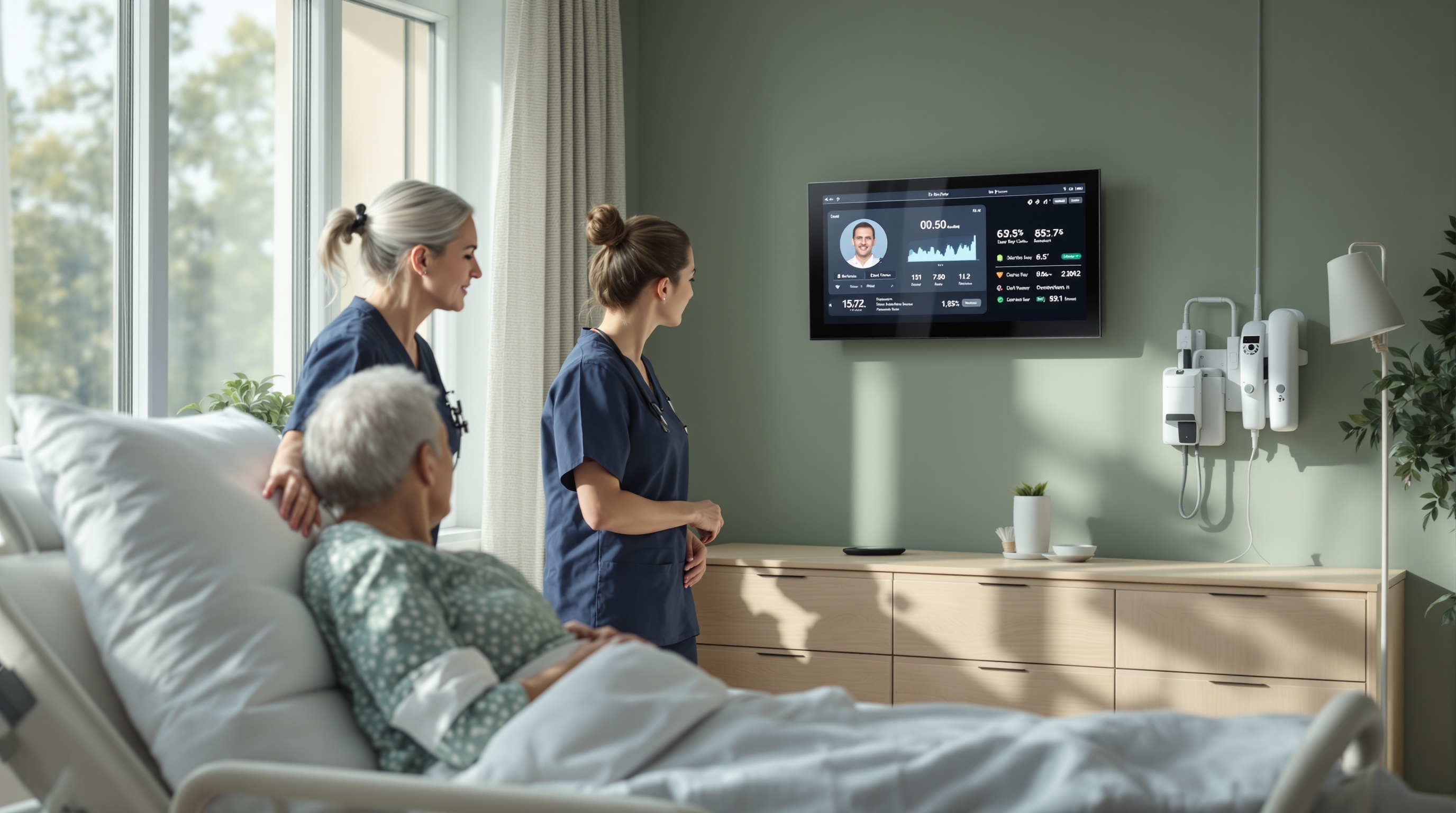Nursing Communication Software: Transforming Skilled Nursing Care
Discover how nursing communication software streamlines workflows and enhances patient care in skilled nursing facilities. Explore key benefits now.
Quick Navigation
- 1. Introduction
- 2. Current Challenges in Nursing Communication Software
- 3. How Sparkco AI Transforms Nursing Communication Software
- 4. Measurable Benefits and ROI
- 5. Implementation Best Practices
- 6. Real-World Examples
- 7. The Future of Nursing Communication Software
- 8. Conclusion & Call to Action
1. Introduction
Did you know that skilled nursing facilities are seeing up to a 40% reduction in communication errors thanks to innovative nursing communication software? As we step into 2025, the landscape of nursing is rapidly transforming, propelled by cutting-edge technologies that were unimaginable just a few years ago. From artificial intelligence streamlining protocols to digital platforms enabling real-time updates, modern communication tools are redefining the way care teams collaborate and deliver patient care.
Yet, despite these advancements, nurses and care staff continue to face persistent challenges: delayed responses, information gaps, and miscommunication can all contribute to medical errors and stress—directly impacting patient outcomes and staff satisfaction. In the high-stakes environment of skilled nursing facilities, even small lapses in communication can lead to significant consequences for vulnerable populations.
So, how can nursing communication software bridge these gaps and empower care teams to deliver safer, more efficient care? In this article, we’ll explore the latest trends shaping nursing communication in skilled nursing facilities, including the integration of artificial intelligence, digital communication platforms, and best practices for implementation. We’ll also examine the real-world challenges and the transformative impact these solutions are having on patient outcomes, workflow efficiency, and job satisfaction. Whether you’re a facility leader, a nurse, or a healthcare technology enthusiast, read on to discover how the right communication tools can elevate your team—and your quality of care—into the future.
2. Current Challenges in Nursing Communication Software
Nursing communication software has become a cornerstone in modern healthcare facilities, aiming to streamline workflows, reduce medical errors, and enhance patient outcomes. Despite its promise, implementation and daily use of these technologies still present significant obstacles for skilled nursing facilities, hospitals, and other care settings. Below are the most pressing challenges, underpinned by current research and industry data.
-
1. Integration with Existing Systems
Many healthcare facilities rely on a patchwork of legacy electronic health record (EHR) systems, scheduling platforms, and communication tools. Integrating new nursing communication software with these existing systems is complex and often incomplete. According to a 2025 Frontiers in Medicine review, nearly 40% of facilities reported significant delays and errors due to poor interoperability between communication tools and core clinical systems. -
2. User Adoption and Training
Successful software deployment requires robust staff training and ongoing support. However, time constraints and workforce shortages mean training is often rushed or insufficient. A 2025 BMC Health Services Research study found that over 30% of nurses reported low confidence in using digital communication tools, contributing to underutilization and workflow disruptions. -
3. Data Security and Privacy Concerns
Protecting sensitive patient information is paramount. Nursing communication software can present vulnerabilities if not properly secured, increasing the risk of data breaches. The same Frontiers in Medicine review noted that more than 25% of healthcare organizations experienced security incidents related to communication platforms in the past year (source). -
4. Alert Fatigue
While real-time alerts are essential for timely care, excessive notifications can lead to “alert fatigue.” Nurses may become desensitized, inadvertently ignoring important messages. Research shows that up to 60% of clinical alerts are overridden or ignored, which can compromise patient safety and delay interventions (Frontiers in Medicine, 2025). -
5. Digital Divide and Accessibility
Not all staff are equally comfortable with new technologies. Variations in digital literacy can result in inconsistent communication and documentation. The BMC study highlighted that older nurses and those in rural facilities were twice as likely to report difficulties accessing or effectively using digital communication tools. -
6. Compliance and Documentation Burden
Regulatory requirements demand comprehensive documentation of patient interactions and care handoffs. Nursing communication software should facilitate, not complicate, this process. However, 45% of nurses surveyed reported that software platforms often added to their administrative workload, increasing the risk of documentation errors and non-compliance (BMC Health Services Research, 2025). -
7. Reliability and Downtime
Technical issues, including outages or slow performance, can severely impact patient care and workflow continuity. Even short periods of downtime can disrupt medication administration, handoff communication, and emergency responses.
The cumulative effect of these challenges is profound: operational efficiency suffers, compliance risks increase, and, most importantly, patient care quality can be compromised. Addressing these pain points demands a multifaceted approach—combining robust software solutions, comprehensive training programs, and ongoing evaluation to ensure that technology truly serves the needs of both nurses and patients.
3. How Sparkco AI Transforms Nursing Communication Software
Effective communication is essential in skilled nursing facilities, where timely information sharing can directly impact patient care and staff efficiency. Traditional nursing communication software often struggles with fragmented updates, delayed responses, and integration issues with other healthcare systems. Sparkco AI addresses these challenges head-on, delivering a modern, intelligent solution that streamlines workflows and improves collaboration across the care team.
-
Real-Time Messaging and Alerts
Sparkco AI enables instant, secure messaging among nurses, physicians, and allied health professionals. Through AI-driven prioritization, urgent messages are flagged and routed to the right team members, reducing response times and ensuring critical updates never go unnoticed. Automation filters routine notifications so staff can focus on what truly matters. -
Intelligent Task Management
The platform automatically tracks tasks, reminders, and follow-up actions assigned to each nurse. AI analyzes workflow patterns and sends proactive reminders for medication administration, wound care, or patient repositioning. This reduces missed tasks and lightens administrative burdens, allowing nurses to dedicate more time to direct patient care. -
Seamless Shift Handover Tools
Sparkco AI transforms shift handover by generating concise, AI-summarized reports of patient status, care plans, and recent interventions. Automated handoff templates ensure essential information is communicated clearly, cutting down on errors and improving continuity of care during shift changes. -
Integrated Documentation Support
With natural language processing, Sparkco AI simplifies documentation. Nurses can dictate or type notes, and the platform automatically organizes and populates electronic health records (EHRs) with relevant data. This reduces duplicate work and ensures that records are up-to-date, accurate, and easily accessible. -
Multilingual Communication Assistance
In diverse care environments, language barriers can hinder effective communication. Sparkco AI offers real-time translation, enabling staff and patients to connect in their preferred language. This fosters inclusivity and minimizes misunderstandings that could compromise care quality. -
Robust Integration with Existing Systems
Sparkco AI is designed for easy integration with major EHRs, nurse call systems, and scheduling platforms. Through secure APIs and standardized data protocols, it connects seamlessly to a facility’s digital ecosystem, eliminating information silos and enabling a unified workflow.
By harnessing the power of AI and automation, Sparkco AI addresses long-standing nursing communication software challenges. Its intuitive interface, smart workflows, and deep integration capabilities empower skilled nursing facilities to enhance team coordination, reduce errors, and deliver safer, more efficient care—without the complexity or steep learning curves of legacy systems.
4. Measurable Benefits and ROI
Automated nursing communication software is transforming operational efficiency and patient care in skilled nursing facilities (SNFs) and hospitals. By streamlining workflows, improving real-time communication, and reducing manual processes, these platforms deliver significant financial and operational benefits. Below, we highlight key data-driven benefits, supported by case studies and industry research.
-
Significant Labor Cost Reduction
Automated communication tools can lead to substantial cost savings in staff labor. According to an OnCall ROI handout, a single facility with 55 staff members and 18 beds reported saving over $65,000 per department per year after implementing automated scheduling and communication software. -
Time Savings in Staff Coordination
Manual communication methods—such as phone calls, paging, and paper notes—consume valuable nursing hours. Automated systems have demonstrated a 75% reduction in time spent on scheduling and coordination. This time can be redirected to direct patient care, leading to improved satisfaction and outcomes. -
Decreased Communication Delays
Automated messaging platforms enable instant, targeted notifications to relevant staff. Published case studies report a 50% faster response time for urgent requests, reducing bottlenecks and improving care coordination. -
Fewer Missed or Delayed Tasks
With built-in task tracking and escalation features, these platforms can decrease the rate of missed or delayed tasks by up to 40%, ensuring critical interventions happen on time. -
Improved Regulatory Compliance
Automated audit trails and secure messaging support HIPAA compliance and facilitate easier reporting during audits. Facilities using advanced communication solutions have reported a 30% reduction in compliance-related incidents due to improved documentation and traceability. -
Enhanced Staff Satisfaction and Retention
Streamlined communication reduces staff frustration and burnout. Facilities leveraging Spok’s solutions, for example, have seen measurable increases in staff satisfaction and retention rates, with one study noting a 20% improvement in nurse satisfaction scores (Spok Customer ROI Metrics). -
Reduced Overtime and Agency Dependence
By automating shift notifications and filling open shifts faster, facilities have cut overtime costs by as much as 15-20% and reduced reliance on costly agency staff. -
Better Patient Outcomes
Improved communication has a direct effect on patient care. Facilities report measurable decreases in adverse events and readmissions, with some studies citing a 10-15% reduction in clinical errors due to faster and clearer staff communication.
The cumulative effect of these benefits results in a compelling return on investment (ROI) for nursing communication software, as evidenced by industry leaders such as Spok and OnCall Scheduling. For skilled nursing facilities aiming to improve efficiency, compliance, and patient care, automated communication is a proven, data-backed solution.
5. Implementation Best Practices
Successful adoption of nursing communication software in skilled nursing facilities hinges on a structured approach that considers regulatory mandates, staff engagement, and resident safety. The following best practices will guide your facility through a smooth and compliant implementation process.
-
Conduct a Needs Assessment and Compliance Review
Begin by evaluating your facility’s communication challenges and mapping them to CMS guidelines, such as those outlined in the 2024-2025 CMS Guidelines. Engage interdisciplinary teams to identify workflow gaps and ensure the software aligns with both clinical and regulatory requirements.
- Tip: Use recent survey citations and incident reports to prioritize needs.
- Pitfall: Failing to incorporate compliance requirements can lead to costly retrofits later.
-
Select the Right Vendor and Solution
Choose software with proven integrations, user-friendly interfaces, and robust support. Confirm that the system meets HIPAA and CMS security standards.
- Tip: Request references from similar-sized facilities.
- Pitfall: Overlooking vendor’s history with regulatory compliance.
-
Engage Stakeholders Early
Involve nurses, administrators, and IT teams from the outset. Early engagement fosters buy-in and uncovers workflow nuances.
- Tip: Hold focus groups or pilot sessions with front-line staff.
- Pitfall: Rolling out the system without user input can result in resistance or underutilization.
-
Develop a Comprehensive Training Plan
Provide role-specific, hands-on training to ensure staff can confidently use the software. Incorporate ongoing education for new hires and system updates.
- Tip: Use scenario-based training to simulate real-life emergencies or care transitions.
- Pitfall: One-time training sessions may lead to skill gaps over time.
-
Establish Clear Communication Protocols
Standardize message escalation, handoff processes, and documentation practices within the software. Make sure these align with your facility’s policies and CMS expectations for quality and safety.
- Tip: Create quick-reference guides for different shifts.
- Pitfall: Ambiguous protocols can cause delays or missed communications.
-
Monitor, Audit, and Optimize
Regularly review usage data, staff feedback, and CMS survey outcomes. Use analytics to identify bottlenecks and track compliance with communication standards.
- Tip: Schedule quarterly reviews and solicit anonymous feedback.
- Pitfall: Neglecting post-implementation monitoring can allow issues to persist.
-
Plan for Change Management and Continuous Improvement
Prepare staff for change by communicating benefits and addressing concerns transparently. Celebrate early wins and provide ongoing support to ease transitions.
- Tip: Appoint change champions from nursing and leadership teams.
- Pitfall: Ignoring emotional impacts of change can undermine adoption.
-
Ensure Regulatory Readiness
Keep documentation of all implementation steps, staff training, and policy updates for CMS surveys. Stay informed about evolving regulations to maintain compliance.
- Tip: Subscribe to CMS update alerts and review guidance quarterly.
- <










